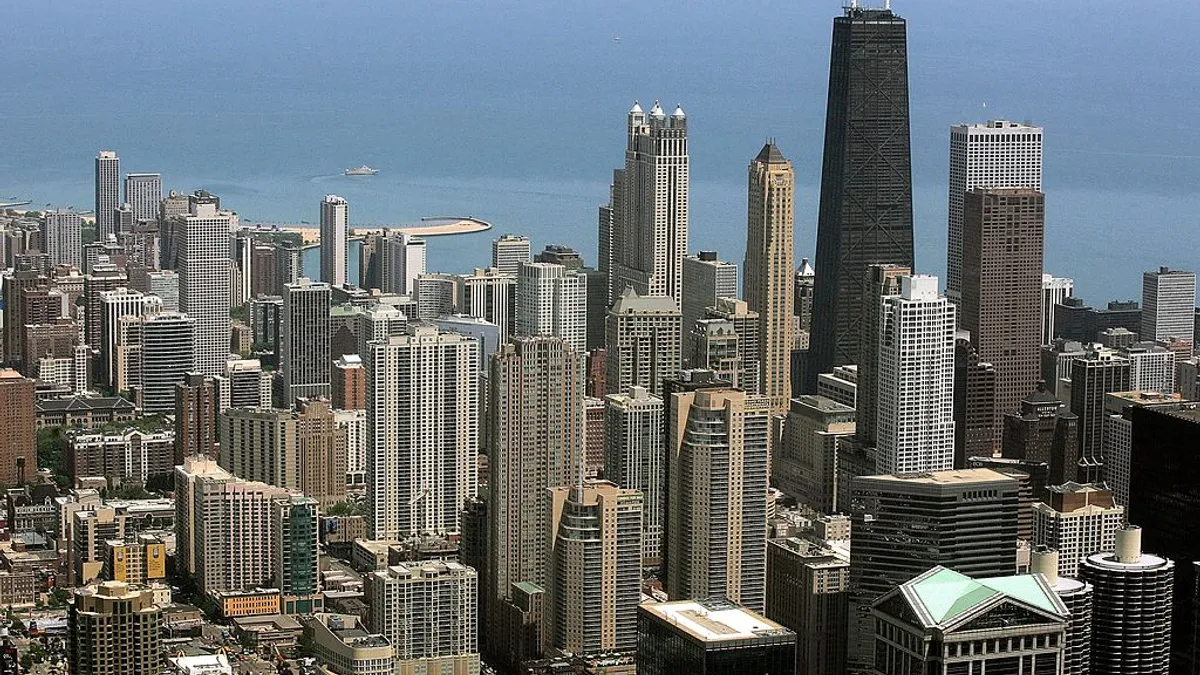For every $1 banks invest in Chicago’s White neighborhoods, they lend 12 cents in Black neighborhoods and 13 cents in Hispanic neighborhoods, according to a 2020 study by WBEZ-FM and the nonprofit newsroom City Bureau.
To remedy underinvestment in majority-Black and Latino neighborhoods, Chicago mayoral candidate Ja’Mal Green this week proposed the creation of a public bank modeled after the Bank of North Dakota, the only public state-owned bank in the country.
Creating a public “Bank of Chicago”, Green said, would counteract decades of redlining that has 68.1% of the dollars banks loaned for housing going to majority-White neighborhoods, while 8.1% and 8.7% go to majority-Black and majority-Latino neighborhoods, respectively.
Chicago Mayor Lori Lightfoot is 2½ years into Invest South/West, her plan to rebuild 10 neighborhood commercial corridors that have fallen into disrepair. But that program misses the mark on fixing the issues in a way that a public bank would not, Green told the Chicago Sun-Times.
“We have more vacant properties in these communities than we have people. We need new homeowners. We need grocery stores. We need affordable housing. We need to rebuild communities similar to what they did in Pullman, where they brought jobs. They brought retail. They brought homeowners. They did everything that needs to happen,” Green said in an announcement. “With a public bank, we can look at the quality of life of these neighborhoods and see how we could tackle all of those things at one time instead of just saying, ‘We’ll throw a few dollars at this project or this project.’ These communities have been suffering for too long. That’s too slow to develop. We have to do it all en masse.”
The Bank of Chicago would start with $500 million in assets, with half of the money coming from the city’s “cash on hand,” though Green did not specify if he meant assets invested by the city treasurer’s office or the funds generated from the sale of the Chicago Skyway, the Sun-Times reported. The other half could come from federal stimulus funds, or if necessary, the Illinois General Assembly could be asked to “match funds,” Green said.
The Bank of North Dakota, established in 1919, is the sole public bank in the U.S. Last year, however, lawmakers in Washington, Oregon, Philadelphia, San Francisco and New York introduced bills to establish a public bank. Though unanimously approved by the city council, Philadelphia Mayor Jim Kenney refused to provide funding for the city’s proposed public bank, the Philadelphia Public Financial Authority, in July.
New York’s public bank bill was blocked from a vote in the state Senate in May despite being introduced by the chair of the Senate’s banking committee, and having 30 co-sponsors. Industry pushback blocked the effort, The City reported. Several of the nation’s largest banks have hired firms for “direct lobbying” on public banking measures, according to the outlet.
Green knows this.
“Private banks are powerful. They have lobbyists. Even in other states, they have spent a lot of money to stop this from happening,” Green told the Sun-Times.
However, creating a public bank would be redundant in a marketplace “where financial offerings already efficiently meet customer needs,” the American Bankers Association wrote. It also could be “potentially dangerous — placing taxpayer funds in institutions that may not have deposit insurance and whose business decisions will be driven by political priorities instead of sound risk management.”
WBEZ, meanwhile, found a racial disparity in how banks lend for home purchases, with JPMorgan Chase 41 times more likely to lend in Chicago’s White neighborhoods than in its Black ones, and Bank of America 29 times more likely.
Both banks, it should be noted, launched recent initiatives to increase Black and Latino homeownership.
Green’s plans aren’t a first in Chicago. Former Alderperson Ameya Pawar, now a senior fellow at liberal think tank Economic Security Project, campaigned for city treasurer in 2019 on plans to create a public bank.
“[Tax increment financing], low-income tax credits, Invest South/West, grants, philanthropy — all of the tools the city currently utilizes — are well intentioned. But they will never work on scale. When you look at history, it is systematic bank lending to homeowners and business owners that gives you Lincoln Square, Ravenswood and Lincoln Park,” Pawar told the Sun-Times, adding that it’s time to stop “trying to solve for a lack of systematic lending in Black and Brown communities with everything but systematic lending.”











